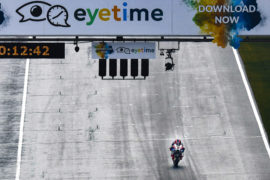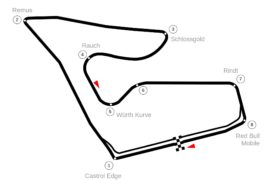The 2017 British Grand Prix at Silverstone is the race that nearly didn’t happen. OK, that’s an exaggeration: Dorna was always going to ensure that a British Grand Prix would happen.
The British Isles are such an important market that it is unthinkable for the series not to race here. But the collapse of the Circuit of Wales project meant that a lot of negotiation had to go into ensuring that the British round of MotoGP would actually take place.
For many observers, the refusal of the Welsh Government to underwrite the construction of the circuit was inevitable. The numbers being claimed seemed at best wildly optimistic, and at worst woefully inaccurate.
Was Dorna wrong to get into bed with the Heads of the Valley Development Company, the organization behind the Circuit of Wales? Possibly. Dorna has a history of making deals with circuits that never get built, as anyone who can recall the saga of the Balatonring can surely tell you.
Then again, what has Dorna lost? They signed a deal with the Circuit of Wales for five years starting in 2015, with an option to extend for a further five years. The deal was reportedly lucrative, well above what Silverstone was offering to pay to host the race.
Donington Park was no competition at the time, the circuit in financial difficult and badly in need of upgrades. Since the deal was signed, Dorna has had two successful races at Silverstone, for which they have been well paid.
When the Circuit of Wales project collapsed, Silverstone stepped in to take over. Dorna will still be paid by Silverstone, though it will be less than the Circuit of Wales would have paid.
Falling on Their Feet
Since they signed the contract with the Circuit of Wales, the financial situation of Silverstone has improved slightly, and Donington has been bought by MSV, who own several other circuits in the UK.
MSV has big plans for Donington, hoping to upgrade facilities to make the track capable of hosting MotoGP. In the negotiations for the future location of the British Grand Prix, Dorna now holds a stronger hand, able to play Silverstone and Donington off against each other.
Of course, this advantage is entirely serendipitous, and not particularly of Dorna’s making. They just happened to get lucky after the Circuit of Wales fell through. But luck or skill, it’s all money in Dorna’s bank.
Right now, though, we are at Silverstone. In many ways, a unique track: very fast, flowing in parts, wide and nearly flat, and because it’s flat, it’s sometimes hard to see exactly which way the track goes.
That can catch out the unwary, as the track has plenty of complex corner complications: the triple chicane at Maggotts – Becketts – Chapel; the section around Club; the convoluted interior section containing Village, The Loop, and Aintree.
The track is flat because it sits on top of a hillside, once used as an airfield, and this means that it is always windy.
Worst of all, perhaps, are the bumps. Because the track is also used extensively by cars, and especially by Formula One (it is, after all, owned by the British Racing Drivers’ Club), the tarmac has plenty of ripples.
The surface was already pretty bad last year – the subject of resurfacing was raised in last year’s Safety Commission – and there are concerns the track will be much worse now.
The changes to F1 mean that the cars have more downforce and bigger tires, and that means more braking force converted into energy going into the asphalt.
That, in turn, means bigger ripples in braking zones, especially in points where riders are tipping the bike into the corner. That makes riding at Silverstone treacherous, where mistakes are severely punished.
Different Strokes
Not everyone minds, of course. For Pol Espargaro, for example, the added difficulties allow the rider to make more of a difference. “I really like the tracks that have something different, something special, that the rider needs to do something extra,” the Red Bull KTM rider said.
“Not the smooth tracks with normal corners, easy corners that in the end, the bike has all the power. At tracks where it’s windy, even raining, or damp conditions, or bumpy or whatever, because maybe I never had a top bike in MotoGP, I like this feeling.”
“And I think it’s where you can take more advantage, the rider can make the difference a little bit, at least. This track has always been quite bumpy, difficult, tricky, the first part of the track. I think it’s a different track, and I really like it, I enjoy.”
Espargaro is the exception in liking the bumps, rather than the rule. For most bikes, the bumps make finding a decent setup difficult.
“It’s very difficult to find the right setup for the bumps,” Andrea Dovizioso explained, “because if you’re working a lot on the bumps, it’s a different story than working on the braking and turning and all the other stuff.”
Electronics play a crucial part over the bumps, Dani Pedrosa added, handling the sudden loss of grip both in braking and acceleration which happens over the bumps.
The bumps make it hard for more sensitive riders as well. “It was a little bit of a problem for me last year,” Jorge Lorenzo said. “Honestly, with the Yamaha, it didn’t allow me to be a bit more comfortable and be faster, and I struggled so much with the bumpy stuff, and also the cold conditions with hard tires.”
Michelin have a different range of compounds this year, and they should provide a little more grip. But for riders like Lorenzo, for whom grip and corner speed is everything, it’s hard to ride at the limit of grip when the bumps keep tossing the bike into the air.
Track Phrenology
The bumps could well be crucial in deciding the winner on Sunday. The bike that handles the bumps best, and the rider and team that find their way around the bumps fastest will have a big advantage come Sunday afternoon.
Quickly finding a setup for the bumps will be crucial, so the teams can turn their attention to tire wear. Complicating those efforts will be the fact that the race will be run much later than usual.
Race time is 3:30pm UK time, to avoid a direct clash with the F1 race at the iconic Spa Francorchamps in Belgium. The trouble is, MotoGP will be practicing at 2pm on Friday and Saturday, when air and track temperatures will be different.
Which bike is better over the bumps? Maverick Viñales was the most optimistic of the three MotoGP brands in the press conference. “If the track is like last year, I think our bike works quite well,” the Movistar Yamaha rider said.
“Especially at bumpy tracks like Argentina and Austin, our bike was working very well through these sections. So we’re going to hope it works the same here.”
Andrea Dovizioso was less of a fan, but still relatively positive. “I don’t think it will be a big problem for our bike compared to the competitors, but we have to look how will be the track.”
Dani Pedrosa was the most concerned of the riders in the press conference. “Last year it was difficult I remember, I don’t know how the track is today, but this year, we’ve been a little bit not on the right point when the track was bumpy, so of course we make a lot of work regarding this to be more comfortable on the bumps.”
Aleix Espargaro put the Aprilia RS-GP firmly in the Honda camp. “Tricky, very very tricky,” he said. “In the tracks where it was bumpy, I suffer a lot, especially I think it was Austin. But I’m positive. We’ll start and we’ll see. We tried many things in Austin, we couldn’t find a good compromise with the bumps, so we’ll try a different direction here.”
His brother Pol was happier with the performance of the KTM RC16 over the bumps. “At the beginning of the season it was really unstable, but also we were trying to discover the correct rigidity of the chassis to be comfortable on track.”
“But step by step, we started with fairing, then different rigidities on the chassis, and different links, and different sizes of the bike, and now I think we have a quite good stiffness of bike, the bike feels good on the bumps, it’s soft but not too soft, it’s hard but not too hard.”
“The only problem we has is maybe turning, but I think the stability on the straight and on the bumps is really good, and I think it’s going to be an interesting weekend for us.”
Revolution Afoot?
Silverstone could turn out to have an inordinate effect on the championship. Marc Márquez may lead the championship by 16 points, he stands to lose some more ground this weekend.
The Honda has been poor over the bumps this year, both Repsol Hondas crashing out in Argentina, for example. If the bumps at Silverstone are worse than they were in 2016, then a mistake could be very costly indeed.
The Ducatis should do well, the bike being relatively good over the bumps. Andrea Dovizioso will have to keep a cool head and focus on finishing, but Silverstone offers a chance to claw back some points from the championship leader.
But the British Grand Prix offers the best chance for the Yamahas to make up ground in the title chase.
Maverick Viñales rode to a brilliant victory last year aboard the Suzuki, so it is clearly a track that suits him. It also suits the Yamaha, with Valentino Rossi having been on the podium for the third year in succession in 2016.
Old Dog as Dark Horse
Under normal circumstances this year, Viñales would be the danger man at Silverstone: the young Spaniard is strong here and the bike is good over the bumps. Viñales also won at Argentina, another bumpy track.
But Rossi looks to be the dark horse at the British GP. He was second in Argentina, then second again in Austin, another bumpy track.
More intriguingly, he is starting to downplay his own chances. He told Italian journalists, “I don’t see myself being in the title fight, we are not competitive enough to get back points from Márquez and Dovizioso.”
The problems are well-known: a lack of grip in the second half of the race, when it is most crucial. “We are in a difficult moment technically, I have to grit my teeth and do the maximum to come back to being competitive.”
Yet Rossi is aiming for a podium at least at Silverstone, and with some reason. It is also his 300th premier class start, having raced in both 500cc and in every incarnation of MotoGP (990cc, 800cc, 1000cc).
Trailing Marc Márquez by 33 points, and his teammate by 9 points, Silverstone would be a good race for Rossi to get back to winning ways.
KTM Reshuffling for Success
With the teams all reassembled after Austria, there were one or two tidbits of news. Bradley Smith has a new crew chief, Tom Jojic having been dropped in favor of Esteban Garcia.
Garcia was the crew chief for KTM’s test team, and has been with the project from day one. The decision to drop Jojic was made by Pit Beirer, KTM’s head of racing. Beirer analyzed what was going on, and felt Garcia was better placed to help Smith succeed rather than Jojic.
Smith was willing to accept the choice of Beirer, despite having had a very close relationship with Tom Jojic since their days together in Moto2. “I follow whatever their [KTM’s] decisions are.”
“At the end of the day, when I look at what Pit has managed, over the course of his career, and what he continues to manage, I go with whatever that guy honestly thinks.”
“He came. He analyzed both in Brno and Spielberg and made the decision on Sunday night after Spielberg. I don’t question anything, if that’s what that guy observes and believes and I’ll follow whatever that plan is.”
The willingness to replace Bradley Smith’s crew chief is just one sign of how determined KTM is to succeed. Another sign came when Pol Espargaro revealed how many different chassis the factory had tested since the start of the season.
“I can tell you without lying, around 18. 18, 17 chassis,” he said. Then there were modified versions of those basic chassis. “And after, we modified them,” he said. “I mean, we can multiply that by as many times as we want.”
This explains why the results of the KTM riders has sometimes seemed a little erratic. “The thing is, because we didn’t have time to do enough test, it happened that at one race we would be really far back, then maybe one race we would be better, and then one race at the back again, because we were testing,” Pol Espargaro said.
They were running out of time to do private testing, and were simply testing at the race track. They may not be winning races just yet, but for a brand new project, the KTM is progressing incredibly rapidly.
KTM doesn’t start any project without an expectation of being able to win. That moment could be sooner, rather than later.
This article was originally published on MotoMatters, and is republished here on Asphalt & Rubber with permission by the author.




